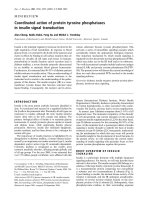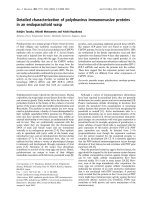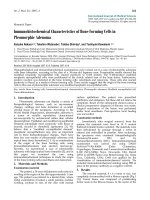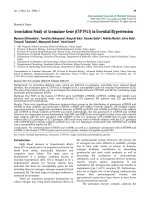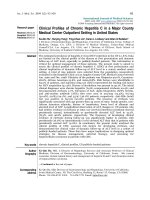Báo cáo y học: "Quasi-MSn identification of flavanone 7-glycoside isomers in Da Chengqi Tang by high performance liquid chromatography-tandem mass spectrometry." ppsx
Bạn đang xem bản rút gọn của tài liệu. Xem và tải ngay bản đầy đủ của tài liệu tại đây (827.2 KB, 10 trang )
BioMed Central
Page 1 of 10
(page number not for citation purposes)
Chinese Medicine
Open Access
Research
Quasi-MS
n
identification of flavanone 7-glycoside isomers in Da
Chengqi Tang by high performance liquid chromatography-tandem
mass spectrometry
Fengguo Xu
1,2
, Ying Liu
3
, Zunjian Zhang*
1,2
, Cheng Yang
1,2
and Yuan Tian
1,2
Address:
1
Key Laboratory of Drug Quality Control and Pharmacovigilance (Ministry of Education), China Pharmaceutical University, Nanjing,
Jiangsu 210009, PR China,
2
Center for Instrumental Analysis, China Pharmaceutical University, Nanjing, Jiangsu 210009, PR China and
3
Department of Pharmacy, Nanjing Municipal Hospital of Traditional Chinese Medicine, Nanjing, Jiangsu 210001, PR China
Email: Fengguo Xu - ; Ying Liu - ; Zunjian Zhang* - ;
Cheng Yang - ; Yuan Tian -
* Corresponding author
Abstract
Background: Da Chengqi Tang (DCT) is a common purgative formula in Chinese medicine.
Flavanones are its major active compounds derived from Fructus Aurantii Immaturus. The present
study developed an LC-MS/MS method to characterize two pairs of flavanone 7-glycoside isomers,
i.e., hesperidin versus neohesperidin and naringin versus isonaringin.
Methods: After solid phase purification, components in sample were separated on a Agilent
zorbax SB-C18 (5 μm, 250 mm × 4.6 mm) analytical column. ESI-MS and quasi-MS
n
were performed
in negative ion mode to obtain structural data of these two pairs of flavanone 7-glycoside isomers.
Moreover, UV absorption was measured.
Results: There was no intra-pairs difference in the UV-Vis and MS/MS spectra of the two pairs of
7-glycoside isomers, whereas the mass spectrometry fragmentation pathways between pairs were
different.
Conclusion: The present study developed a LC-MS/MS method to explore the inter- and intra-
pair difference of two pairs of flavanone 7-glycoside isomers.
Background
Described in Shanghan Lun (Treatise on Cold Damage Dis-
eases, a Chinese medicine classic from the Han dynasty)
[1], Da Chengqi Tang (DCT) is a well known purgative for-
mula consisting of Radix et Rhizoma Rhei (Dahuang), Cor-
tex Magnoliae officinalis (Houpu), Fructus Aurantii
Immaturus (Zhishi) and Natrii Sulfas (Mangxiao). DCT is
usually used to treat diseases such as acute intestinal
obstruction without complications, acute cholecystitis
and appendicitis [2]. DCT is also used in treating posttrau-
matic respiratory distress syndrome [3], reducing acute-
phase protein levels in patients with multiple organ fail-
ure syndromes [4] and relieving inflammation in patients
after tumor operation [5]. Recently DCT was found to pos-
sess anti-inflammatory effects apart from its purgative
activities [6].
Flavanones are a major type of active components in DCT
[1,6]. Various studies have revealed a variety of pharmaco-
logical activities that citrus flavanones possess, such as
Published: 24 July 2009
Chinese Medicine 2009, 4:15 doi:10.1186/1749-8546-4-15
Received: 20 December 2008
Accepted: 24 July 2009
This article is available from: />© 2009 Xu et al; licensee BioMed Central Ltd.
This is an Open Access article distributed under the terms of the Creative Commons Attribution License ( />),
which permits unrestricted use, distribution, and reproduction in any medium, provided the original work is properly cited.
Chinese Medicine 2009, 4:15 />Page 2 of 10
(page number not for citation purposes)
enzyme inhibition, free radical scavenging, anti-inflam-
mation, anti-estrogen and inhibition of tumor progres-
sion [7-13]. Moreover, flavanones have isomers. Our
previous study [14] found that hesperidin and neohespe-
ridin, naringin and isonaringin (Figure 1) are two pairs of
flavanone 7-glycoside isomers in DCT. The relationships
between the chemical structures and their chromatogra-
phy retention time, ultraviolet-visible (UV-Vis) spectra,
MS/MS spectra are yet to be investigated.
HPLC methods, either alone or combined, have been
used to determine hesperidin, naringin and neohesperi-
din in Chinese medicinal materials [15-19]. Meanwhile,
flavonoids were also studied via mass spectra fragmenta-
tion pathway [20-22]. Zhou et al. [23] described a liquid
chromatography-electrospray mass spectrometry (LC-ESI/
MS) method to characterize O-diglycosyl flavanones of
Fructus Aurantii (Zhiqiao) and ultra-pressure liquid chro-
matography (UPLC) retention parameters method to
delineate the structure-retention relationship of these O-
diglycosyl flavanones. The multiple stage mass spectra
fragmentation pathway especially the C-ring related frag-
mentations of these flavanones are to be studied.
Triple stage quadruple (TSQ) tandem mass spectrometry
is used to quantify chemicals and provide sufficient struc-
tural information through MS/MS spectra. Kevin et al.
[24] first reported a quasi-MS
n
(up to MS
3
) method for
analyzing isomeric sulfonamide in milk. The quasi-MS
n
method is now widely accepted [25,26].
The present study aims to develop a rapid solid-phase
extraction LC-MS/MS method to investigate the intra- and
inter-pair difference of two pairs of flavanone 7-glycoside
isomers in terms of peak retention time, UV-Vis spectra
and multistage MS spectra in accordance with the quasi-
MS
n
method.
Methods
Chemical and reagents
Reference standards for hesperidin (Batch No: 110721-
200512) and naringin (Batch No: 110722-200309) were
purchased from the Chinese National Institute for the
Control of Pharmaceutical and Biological Products
(China). Neohesperidin (Batch No: 05-1010) was pur-
chased from the Shanghai Research and Development
Center for Standardization of Chinese Medicines (China).
Methanol (HPLC grade) was purchased from VWR Inter-
national (Germany). Formic acid (analytical grade) was
purchased from Nanjing Chemical Reagent First Factory
(China). Water was distilled twice before use.
The medicinal herbs and material used in the present
study, i.e. Radix et Rhizoma Rhei, Cortex Magnoliae officina-
lis, Fructus Aurantii Immaturus and Natrii Sulfas, were pur-
chased from a traditional Chinese medicine shop in
Structures of naringin (A), isonaringin (B), neohesperidin (C) and hesperidin (D)Figure 1
Structures of naringin (A), isonaringin (B), neohesperidin (C) and hesperidin (D).
Chinese Medicine 2009, 4:15 />Page 3 of 10
(page number not for citation purposes)
Nanjing, China. Prof Ping Li at the Key Laboratory of
Modern Chinese Medicines, Pharmaceutical University,
China authenticated the medicinal herbs and material
using microscopic identification method.
Instruments and conditions
High-performance liquid chromatography-diode array
detection (HPLC-DAD) analysis was performed on a liq-
uid chromatography system (Agilent 1100 Series, Agilent
Technologies, USA) equipped with a quadruple pump
and a DAD detector. Data were acquired and processed
with HP ChemStation software. Chromatography was car-
ried out on an Aglient Zorbax SB-C18 column (5 μm, 250
mm × 4.6 mm) at 45°C column temperature. Mobile
phase: methanol/water (0.2% formic acid) = 60/40, flow
rate 1.0 ml/min. Peaks were monitored at 285 nm and UV
spectra were recorded.
LC-MS/MS experiments were conducted on a Finnigan
Surveyor HPLC system (Thermo Electron, USA) coupled
with a Finnigan autosampler. The HPLC eluant from the
column was introduced into (via a 1:4 split) a Finnigan
TSQ Quantum Discovery Max system (Thermo Electron,
USA) coupled with an electrospray ionization source. The
mass detection was conducted on. The spray voltage was
4.5 kv and the capillary temperature was 300°C. Nitrogen
was used as nebulizing and auxiliary gas. The nebulizing
gas back-pressure was set at 40 psi and auxiliary gas at 20
psi. Argon was used as the collision gas in MS/MS. Data
acquisition was performed with Xcalibur 1.2 software
(Thermo Finnigan, USA).
Improved quasi-MS
n
approach
We modified the quasi-MS
n
method [24-26] for the
present study. In the first order mass spectrometry, the
source collision-induced dissociation (source CID) and
CID were set at 5 and 0 respectively to obtain the first
order precursor ions. The quasi-MS/MS and MS/MS spec-
tra were obtained under condition set A (source CID = 70,
CID = 0) and condition set B (source CID = 5, CID = 30)
respectively and were compared to selected quasi-second
order precursor ions. The selected quasi-second order pre-
cursor ions underwent CID in the collision quadruple to
yield useful structure-specific product ions which are
referred to as quasi-MS/MS/MS ions. The comparison of
the spectra of quasi-MS/MS and of quasi-MS/MS/MS may
yield the quasi-third order precursor ions. The quasi-MS
4
spectra may be obtained through collision of the ions
with argon in CID.
Preparation of stock solutions
Stock solutions of neohesperidin and naringin were pre-
pared at the concentration of 1.0 mg/ml in methanol and
water (45:55) and stored at 4°C. Stock solution of hespe-
ridin was prepared at 0.5 mg/ml in methanol and water
(45:55) and stored at 4°C. The stock solutions were fur-
ther diluted to working solutions at room temperature.
Preparation of DCT
DCT was prepared in accordance with Shanghan Lun [14].
Cortex Magnoliae officinalis (24 g) and Fructus Aurantii
Immaturus (15 g) were immersed in 500 ml distilled water
and boiled to 250 ml respectively. The two water extracts
were combined. Radix et Rhizoma Rhei (12 g) was then
immersed in the combined water extracts and boiled to
half volume. Natrii Sulfas (6 g) was dissolved in the water
extract, filtered and diluted to 1000 ml with distilled water
and stored at 4°C until use.
Sample pre-treatments
For quantitative analysis, an aliquot (1.0 ml) of DCT was
purified with Lichrospher solid-phase extraction (SPE)
cartridge (250 mg packing, Hanbang, China). The car-
tridge was firstly conditioned with 2 ml of methanol and
then equilibrated with 2 ml of water. After sample was
loaded, the cartridge was washed with 2.0 ml of methanol
(30%). The analyte was eluted with 2.0 ml of methanol
(45%) and diluted with 50% methanol to a final volume
of 5 ml. The solution was filtered through a syringe
organic membrane filter (0.45 μm, Hanbang, China)
before HPLC analysis.
Results and discussion
Optimization of sample pre-treatments procedure and
separation conditions
Various methods including liquid-liquid extraction and
solid-phase extraction were tested during method devel-
opment and sample pre-treatment with C
18
cartridges was
adopted. A solution of methanol (30%) in water was opti-
mized to wash the co-existing hydrophilic components
after sample was loaded. A solution of methanol (45%) in
water was used to elute and separate the four target ana-
lytes from the lipophilic components.
After testing several mobile phases systematically, we
reached the chromatographic conditions used in the
present study. The addition of formic acid to the solvent
system, i.e. methanol and water with 0.2% formic acid
(60:40), and the column temperature (45°C) improved
the separation of naringin, hesperetin and neohesperetin
and helped obtain symmetrical and sharp peaks. The
retention times of naringin, hesperetin and neohesperetin
were 8.0, 9.3 and 10.3 minutes respectively (Figures 2 and
3).
Identification of the two pairs of flavanone 7-glycoside
isomers by LC-MS/MS
We found that hesperidin, neohesperidin and naringin
corresponded to the peaks at retention times of 9.3, 10.3
and 8.0 minutes respectively. Neohesperidin and naringin
Chinese Medicine 2009, 4:15 />Page 4 of 10
(page number not for citation purposes)
were of the same neohesperidose at the carbon 7 of the A-
ring and that hesperidin and isonaringin had rutinose at
the same position. Meanwhile, the chromatographic
retention times of hesperidin and neohesperidin sug-
gested that the same parent chemical structure with ruti-
nose would contribute less than that with neohesperidose
under the same chromatographic conditions. Therefore
we predicted that the retention time of isonaringin would
be less than that of naringin.
An extracted ions chromatography (EIC) of m/z 579.00
and m/z 609.00 to demonstrated that the peaks at reten-
tion times of 9.3 and 10.3 minutes were hesperidin and
neohesperidin respectively (Figure 3A) and that the peaks
at retention times of 5.5 and 8.0 minutes were isonaringin
and naringin respectively (Figure 3B).
Mass spectrometric structure characterization of naringin
and isonaringin
From the first order mass spectrometry scan spectra
(source CID = 5 v, CID = 0 v) of naringin and isonaringin
(Figure 4A), we found that the [M-H]
-
ions were both at m/
z 579. Ions of m/z 271 and m/z 151 were the major prod-
uct ions of [M-H]
-
m/z 579 under the condition set A
(quasi-MS/MS spectra: source CID = 70 v, CID = 0 v) and
condition set B (MS/MS spectra: source CID = 5 v, CID =
30 v) (Figure 4B). After comparing the two spectra, we
selected m/z 271 as quasi-second order precursor ions
Representative HPLC/UV chromatograms of reference standards (A) and DCT (B)Figure 2
Representative HPLC/UV chromatograms of reference standards (A) and DCT (B). The retention times of isonar-
igin, naringin, hesperetin and neohesperetin were 5.5, 8.0, 9.3 and 10.3 minutes respectively (marked with black triangle).
Chinese Medicine 2009, 4:15 />Page 5 of 10
(page number not for citation purposes)
which underwent CID = 30 v to obtain quasi-MS/MS/MS
spectra. We found an unusual phenomenon in the quasi-
MS/MS/MS spectra from m/z 271, i.e. the ions of m/z 227,
203, 199,187, 176, 165, 161 and 107 did not always
appear at each time point of the peaks in total ions chro-
matography (TIC) for naringin and isonaringin, while
ions at m/z 151 and 119 were found at each time point of
the peaks in TIC for the two isomers (Figure 4C). This phe-
nomenon suggested that there might be many unstable
parallel fragmentation pathways from m/z 271. We iso-
lated the quasi-third order precursor ions of m/z 151 by
comparing the spectra of quasi-MS/MS (from [M-H]
-
m/z
579, source CID = 70 v, CID = 0 v) and quasi-MS/MS/MS
(from quasi-second order precursor ion m/z 271, source
CID = 70 v, CID = 30 v) and then impacted in CID with
collision gas (argon; source CID = 70 v; CID = 30 v). We
obtained the quasi-MS
4
spectra (Figure 4D) from m/z 151,
through which we confirmed that ions m/z 107 were gen-
erated from m/z 151.
Figure 5 shows the proposed fragmentation pathway of
naringin and isonaringin based on the quasi-MS
n
method.
The quasi-second order precursor ions at m/z 271 were
generated from [M-H]
-
m/z 579 after the neutral loss of
glycoside: rutinose and neohesperidose for isonaringin
and naringin respectively. The most dominate ions of m/
z151 and 119 from m/z 271 were yielded through retro-
Diels-Alder (RDA) reactions by breaking two C-C bonds
of C-ring, which gave structurally informative ions of A-
ring and B-ring. Concerning the RDA fragmentations, we
Extracted ions chromatogram (EIC) of m/z 609.00 (A) and m/z 579.00 (B) combined with the UV spectraFigure 3
Extracted ions chromatogram (EIC) of m/z 609.00 (A) and m/z 579.00 (B) combined with the UV spectra. The
retention times of isonarngin, naringin, hesperetin and neohesperetin were 5.5, 8.0, 9.3 and 10.3 minutes respectively.
Chinese Medicine 2009, 4:15 />Page 6 of 10
(page number not for citation purposes)
Representative first order mass spectra of naringin and isonaringinFigure 4
Representative first order mass spectra of naringin and isonaringin (A: source CID = 5, CID = 0); Representative
quasi-MS/MS from first order precursor ions m/z 579.00 for naringin and isonaringin (B: source CID = 70, CID = 0); Represent-
ative quasi-MS/MS/MS from quasi-second order precursor ions m/z 271.40 for naringin and isonaringin (C: source CID = 70,
CID = 30);. Representative quasi-MS
4
from quasi-third order precursor ions m/z 151.16 for naringin and isonaringin (D: source
CID = 70, CID = 30)
Chinese Medicine 2009, 4:15 />Page 7 of 10
(page number not for citation purposes)
noted that the ions at m/z 151 underwent further CO
2
loss
leading to a fragment at m/z 107 [21], which appeared
both in quasi-MS/MS/MS spectra from m/z 271 and quasi-
MS
4
spectra from m/z 151. The ion at m/z 203 was pro-
posed to be generated from m/z 271 through the C
3
O
2
neutral loss and underwent further C
2
H
2
O loss to frag-
ment at m/z 161, which occurred mainly on the C-ring fol-
lowed by a new cyclization implying the B-ring. In
general, all flavones exhibited neutral losses of CO and
CO
2
that may be attributed to the C-ring [21]. Therefore
the ions at m/z 243 and 227 were proposed as products of
the losses of CO and CO
2
respectively. The ions at m/z 227
would undergo further loss of CO at the position carbon
4' of B-ring and generate ion at m/z 199. A retrocyclisation
fragmentation involving the 0 and 4 bonds was proposed
to form fragments m/z 165 from m/z 271. Therefore
another source of m/z 119 was proposed as a result of the
loss CO and H
2
O from m/z 165.
Mass spectrometric structure characterization of
hesperidin and neohesperidin
The MS spectra of hesperidin and neohesperidin obtained
by quasi-MS
n
(up to MS
3
for this pair of flavanone 7-gly-
coside isomer) method are shown in Figure 6. The [M-H]
-
ions of hesperidin and neohesperidin obtained from the
first order mass spectrometry scan spectra (source CID = 5
v; CID = 0 v) were both at m/z 609. Ions of m/z 301 were
the major product ions of [M-H]
-
under the condition set
A (quasi-MS/MS spectra: source CID = 70 v, CID = 0 v)
and condition set B (MS/MS spectra: source CID = 5 v,
CID = 30 v). Ions at m/z 301 were selected as quasi-second
order precursor ions and underwent CID = 30 v to obtain
quasi-MS/MS/MS spectra. Here we found the same unu-
sual phenomenon, i.e. the ions at m/z 268, 257, 241, 227,
215, 174, 168, 164, 151, 136 and 125 were not always at
each time point of the peaks in TIC for hesperidin and
neohesperidin except the ions at m/z 286. This phenome-
non suggested that there might be many unstable parallel
fragmentation pathways from m/z 301.
Proposed fragmentation of naringin and isonaringin based on quasi-MS
n
(up to MS
4
) spectra in negative ion modeFigure 5
Proposed fragmentation of naringin and isonaringin based on quasi-MS
n
(up to MS
4
) spectra in negative ion
mode.
Chinese Medicine 2009, 4:15 />Page 8 of 10
(page number not for citation purposes)
Representative first order mass spectra of hesperidin and neohesperidinFigure 6
Representative first order mass spectra of hesperidin and neohesperidin (A: source CID = 5, CID = 0); Representa-
tive quasi-MS/MS from first order precursor ions m/z 609.00 for hesperidin and neohesperidin (B: source CID = 70, CID = 0);
Representative quasi-MS/MS/MS from quasi-second order precursor ions for hesperidin and and neohesperidin (C: source CID
= 70, CID = 30)
Chinese Medicine 2009, 4:15 />Page 9 of 10
(page number not for citation purposes)
Figure 7 shows the proposed fragmentation pathway of
hesperidin and neohesperidin. The mass spectrometry
fragmentation behaviors of hesperidin and neohesperidin
were different from those of naringin and isonaringin. The
most stable ions at m/z 286 were not generated through
RDA reactions but formed after the CH
3
· loss from m/z
301. Meanwhile the ions m/z 151 yielded from m/z 301 by
breaking two C-C bonds of C-ring became weak and were
not in the quasi-MS/MS spectra from m/z 609. The ion at
m/z 259 was generated from m/z 301 through the C
3
O
2
neutral loss. A further loss of CO
2
and CH
3
· from these
ions led to fragments at m/z 215 and 244 respectively.
After further O loss from C-ring, m/z 199 were formed
from m/z 215. Ions at m/z 200 were generated through two
pathways: one was the CH
3
· loss from ions at m/z 215 and
the other was the CO
2
loss at A-ring from ions at m/z 244.
Two ions generated through CO loss from m/z 286 were
attributed to the abundance of fragments at m/z 258. One
of the two ions was generated at carbon 4' of B-ring while
the other was formed involved carbon 4 of C-ring. The
two ions formula of m/z 258 both underwent further O
loss from C-ring and generated two ions formula of m/z
242.
Fragmentation pathways comparison of the two pairs of
flavanone 7-glycoside isomers: hesperidin versus
neohesperidin and naringin versus isonaringin
We found that the mass spectrometry fragmentation
behaviors between the two pairs of flavanone 7-glycoside
isomers were very different, while the within pair mass
spectrometry behaviors were very similar.
For hesperidin and neohesperidin, the fragment ions were
related to CH
3
· loss at the position of carbon 4' of B-ring.
It indicated that the bond between O and CH
3
was found
at an active fragmentation position. The very common
fragmentation by retro-Diels-Alder (RDA) reactions in
terms of flavonoid aglycone became inactive for hesperi-
din and neohesperidin compared with naringin and iso-
naringin. The reason for this was possibly that there was
Proposed fragmentation of neohesperidin and hesperidin based on quasi-MS
n
(up to MS
3
) spectra in negative ion modeFigure 7
Proposed fragmentation of neohesperidin and hesperidin based on quasi-MS
n
(up to MS
3
) spectra in negative
ion mode.
Chinese Medicine 2009, 4:15 />Page 10 of 10
(page number not for citation purposes)
no active fragmentation bond between O and CH
3
in A-
ring and B-ring for naringin and isonaringin. Therefore
the RDA reactions became the dominate fragmentation
pathway for naringin and isonaringin.
Conclusion
The present study developed a LC-MS/MS method to
explore the inter- and intra-pairs difference of two pairs of
flavanone 7-glycoside isomers: hesperidin versus neohes-
peridin and naringin versus isonaringin in DCT in regards
to peak retention time, UV-Vis spectra, multistage MS
spectra obtain by quasi-MS
n
(up to MS
4
) method.
Abbreviations
CID: collision-induced dissociation; DCT: Da Chengqi
Tang; EIC: extracted ions chromatogram; ESI-MS: electro-
spray mass spectrometry; LC-ESI/MS: liquid chromatogra-
phy-electrospray mass spectrometry; HPLC-DAD: high-
performance liquid chromatography-diode array detec-
tion; MS/MS: tandem mass spectrometry; RDA: retro-
Diels-Alder; SPE: solid-phase extraction; TIC: total ions
chromatogram; TSQ: triple stage quadrupole; UPLC:
ultra-pressure liquid chromatography; UV-Vis: ultraviolet-
visible
Competing interests
The authors declare that they have no competing interests.
Authors' contributions
FGX and YL performed the instrumental experiments and
drafted the manuscript. CY and YT analyzed the data and
revised the manuscript. ZJZ supervised all the experiments
and revised the manuscript. All authors read and
approved the final version of the manuscript.
Acknowledgements
This project was financially supported by the Chinese Natural Science
Foundation (No. 30672587), Natural Science Foundation of Jiangsu Prov-
ince (No. BK2006153) and Technology Innovation Program for Post-grad-
uate Studies in Jiangsu Province (No. 2006-135).
References
1. Tian YQ, Ding P: Study progress of Dachengqi decoction on
the aspect of pharmacology, clinical research and related
fields. Zhongyiyao Xuekan 2006, 24:2134-2135.
2. Qi QH, Wang K, Hui JF: Effect of Dachengqi granule on human
gastrointestinal motility. Zhongguo Zhongxiyi Jiehe Zazhi 2004,
24:21-24.
3. Liu FC, Xue F, Cui ZY: Experimental and clinical research of
Dachengqi decoction in treating post-traumatic respiratory
distress syndrome. Zhongguo Zhongxiyi Jiehe Zazhi 1992,
12:541-542.
4. Zhao Q, Cui N, Li J: Clinical and experimental study of effect
on acute phase protein level of multiple organ dysfunction
syndrome treated with Dachengqi decoction. Zhongguo
Zhongxiyi Jiehe Zazhi 1998, 18:453-456.
5. Wang SS, Qi QH: Influence of pre-operational medicated
Dachengqi granule on inflammatory mediator in tumor
patients. Zhongguo Zhongxiyi Jiehe Zazhi 1999, 19:337-339.
6. Tseng SH, Lee HH, Chen LG, Wu CH, Wang CC: Effects of three
purgative decoctions on inflammatory mediators. J Ethnop-
harmacol 2006, 105:118-124.
7. Havsteen BH: Biochemistry and medical significance of the fla-
vonoids. Pharmacol Ther 2002, 96:67-202.
8. Fukr U, Klittich K, Staib AH: Inhibitory effect of grapefruit juice
and its bitter principal, naringenin, on CYP1A2 dependent
metabolism of caffeine in man. J Clin Pharmacol 1993,
35:431-436.
9. Guengerich FP, Kim DH: In vitro inhibition of dihydropyridine
oxidation and aflatoxin B1 activation in human liver micro-
somes by naringenin and other flavonoids. Carcinogenesis 1990,
11:275-279.
10. Bors W, Heller W, Michel C, Saran M: Flavonoids as antioxidants:
determination of radical-scavenging efficiencies. Meth Enzymo
1990, 186:343-355.
11. Lambev I, Krushkov I, Zheliazkov D, Nikolov N: Antiexudative
effect of naringin in experimental pulmonary edema and
peritonitis. Eksperimentalna Meditsinai Morfologiia 1980,
19:207-212.
12. Tang BY, Adams NR: Effect of equol on oestrogen receptors
and on synthesis of DNA and protein in the immature rat
uterus. J Endocrinol 1980, 85:291-297.
13. Nishino H, Nagao M, Fujili H: Role of flavonoids in suppressing
the enhancement of phospholipid metabolism by tumor pro-
moters. Cancer Lett 1983, 21:1-8.
14. Xu F, Liu Y, Zhang Z, Song R, Tian Y: Simultaneous SPE-LC
Determination of Three Flavonoid Glycosides of Naringin,
Neohesperidin and Hesperidin in Da-Cheng-Qi Decoction.
Chromatographia 2007, 9/10:763-766.
15. Tong RS, Sun SM, Wu QX: Determination of hesperidin in fruc-
tus aurantii immaturus by RP-HPLC. Huaxi Yaoxue Zazhi 2000,
15:454-455.
16. Lei H, Feng WH: Determination of Hesperidin in Zhizhu Cap-
sule by HPLC. Zhongguo Shiyan Fangjixue Zazhi 2005, 11:5-6.
17. Yang WL, Yu SP, Yang SL, Ren YD, Li YF: Determination of neo-
heperidin in Fructus Aurantii by RP-HPLC. Shizhen Guoyi
Guoyao 2005, 16:280-281.
18. Liang YY, Feng B, Zhu CC, Ni C: Determination of naringin and
hesperidin in Fructus Aurantii Immaturus by HPLC. Zhong-
guo Xinyao Yu Lingchuang Yaoli 2006, 17:359-361.
19. Yang WL, Yang SL, Zhang M, Huang JL: Determination of naringin
and neohesperidin in fructus aurantii by RP-HPLC. Zhongguo
Xinyao Yu Lingchuang Yaoli 2005, 16:261-263.
20. Cuyckens F, Claeys M: Mass spectrometry in the structural
analysis of flavonoids. J Mass Spectrom 2004, 39:1-15.
21. Fabre N, Rustan I, de Hoffmann E, Quetin-Leclercq J: Determina-
tion of Flavone, Flavonol, and Flavanone Aglycones by Neg-
ative Ion Liquid Chromatography Electrospray Ion Trap
Mass Spectrometry. J Am Soc Mass Spectrom 2001, 12:707-715.
22. Stobiecki M: Application of mass spectrometry for identifica-
tion and structural studies of flavonoid glycosides. Phytochem-
istry 2000, 54:237-256.
23. Zhou D, Xu Q, Xue X, Zhang F, Liang X: Identification of O-dig-
lycosyl flavanones in Fructus aurantii by liquid chromatogra-
phy with electrospray ionization and collision-induced
dissociation mass spectrometry. J Pharm Biomed Anal 2006,
42:441-448.
24. Kevin PB, Steven JL, Dietrich AV: Characterization of isomeric
sulfonamides using capillary zone electrophoresis coupled
with nano-electrospray quasi-MS/MS/MS. J Mass Spectrom
1997, 32:297-304.
25. Dietrich AV, Bashir M, Steven JL: Study of 4-quinolone antibiotics
in biological samples by short-column liquid chromatogra-
phy couple with electrospray ionization tandem mass spec-
trometry. Anal Chem 1997, 69:4143-4155.
26. Joly N, El Aneed A, Martin P, Cecchelli R, Banoub J: Structural
determination of the novel fragmentation routes of mor-
phine opiate receptor antagonists using electrospray ioniza-
tion quadrupole time-of-flight tandem mass spectrometry.
Rapid Commun Mass Spectrom 2005, 19:3119-3130.


